Ankle braces are important tool doctors use to help patients recover from ankle injuries.
Just as important, they can supply the additional joint strength needed to prevent injuries from happening in the first place.
Unfortunately, ankle sprains are an all-too-common occurrence. They can happen anywhere at any time. In addition, ankle joints can be weakened by osteo or rheumatoid arthritis. And it’s not unusual for athletes to dislocate their ankle during the heat of competition.
Below we’ve brought together the 10 best ankle braces for 2023.
Rankings
1. BioSkin Trilok Ankle Brace
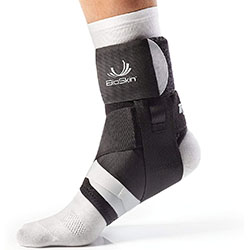
Click here for the lowest price on Amazon
The BioSkin Trilok Ankle Brace provides robust plantar fascia support coupled with rock-solid ankle support. The combination protects you from a wide variety of potential injuries including ankle turns and repetitive stress injuries, including plantar fasciitis.
What we like: This is a great choice if you have repetitive stress issues and an equally good choice for those with arthritis. We appreciate how easy and intuitive the brace is to use. We also appreciate the outstanding arch support.
The band envelopes your arch providing uplift and ensuring the plantar fascia has the support needed to do its job. The upper portion of the brace envelops your ankle with wide, Velcro-secured straps. And the whole mechanism slips into a standard pair of dress or running shoes.
Flaws: It’s pretty expensive. And though it’s an outstanding all-around ankle brace it’s still difficult to justify that price point.
2. McDavid Ankle Brace
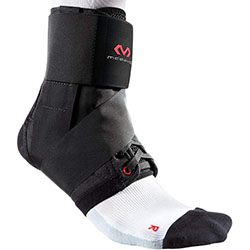
Click here for the lowest price on Amazon
Similar in appearance to the BioSkin brace the McDavid Ankle Brace is actually a tad more involved. It’s intended for those who’ve experienced ankle injuries or who have notable issues related to degenerative conditions like arthritis. Unraveling the McDavid brace reveals just how seriously the company takes the issue of ankle support.
What we like: If you have issues with Achilles tendinitis this is certainly a brace you’ll want to consider. The figure 6 strapping configuration is intended to mimic that of athletic tape.
We like that the front of the brace laces from top to bottom so you can achieve just the right fit and comfort level. And that the brace completely envelopes the Achilles and heel.
Flaws: It’s not an ankle brace for the athletically inclined. By that we mean that if you wear it playing tennis several times a week it will start to lose its composure after a couple of weeks.
3. OrthoSleeve FS6 Compression Foot Sleeve
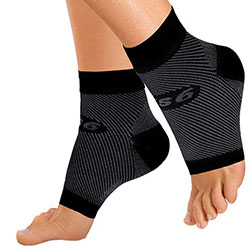
Click here for the lowest price on Amazon
Those who suffer from plantar fasciitis know the shooting pain that often accompanies it. Fortunately, the OrthoSleeve FS6 Compression Foot Sleeve exists to save the day. The support here is truly outstanding. You can feel the upward motion in your arch the minute you slip it on. And that support doesn’t waver even after hours on your feet.
What we like: The FS6 is a true compression sleeve that fits neatly into any standard pair of shoes and can disappear under your dress or athletic socks if you wish. The moisture wicking fabric also keeps your feet cool and dry while discouraging odors.
Flaws: Be careful to keep them out of the washer and dryer unless you want to ruin them. Hand wash and air dry only.
4. Bracoo Ankle Brace w/Dual Spring Stabilizers
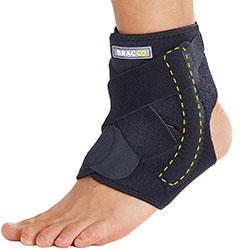
Click here for the lowest price on Amazon
The Bracoo Ankle Brace embraces a simple ‘H’ pattern that folds up around your ankle at one end and envelopes your arch at the other. Once the arch support is in place two straps are pulled up tight and connected to the upper half with sturdy Velcro attachments.
What we like: The neoprene/nylon/spandex weave is comfortable and forgiving. While the discreet metal splints integrated into each side of the upper ensure joint stability.
We also appreciate the open heel that allows for a generous range of motion. On the whole the brace is very breathable, light and durable.
Flaws: That open heel indicates this is not a brace for those dealing with Achilles tendinitis. That’s not so much a flaw as it is a simple fact.
5. RiptGear Ankle Brace for Men and Women
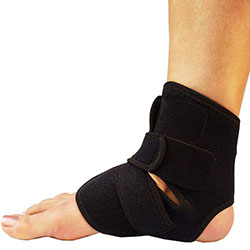
Click here for the lowest price on Amazon
The major difference between this and the just-profiled Bracoo Ankle Brace is that this brace foregoes the integrated metal ankle supports in favor of slightly more robust Velcro strapping. Other than that, they both sport the ‘H’-shaped design that makes putting them on and taking them off so simple.
What we like: You can strap up this puppy and hit the gym with a high degree of confidence. Or put it on before you hit the trail with the kids or grandkids and you won’t have to worry about turning an ankle.
There is no denying this brace provides a comfortable, rock-solid hold while still allowing for plenty of range of motion. It’s also reasonably priced.
Flaws: This one also features that open heel, which means it’s not for those with Achilles issues. Also, it can be a little trickier than some other braces when it comes to finding a comfort zone.
6. Med Spec ASO
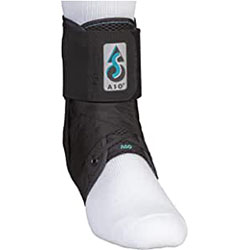
Click here for the lowest price on Amazon
If you’ve suffered from a high ankle sprain or are dealing with Achilles tendinitis consider the Med Spec ASO Ankle Brace. This brace is often recommended by physical therapists and trainers because of its intense ankle support, closed heel and comfortable figure 8 construction.
What we like: The lace is fixed to the tongue to ensure it remains centered at all times. While the stability straps have finger loops that help you take a firm grasp. It’s highly breathable, extremely durable and features a lace up design that enables you to fine tune the fit to your particular needs.
The Med Spec ASO slips easily into all standard footwear and has low visibility seams that prevent irritation. Overall, it’s well-made, compatible with either right or left feet and available in black or white.
Flaws: The downside of the lacing is that it takes a lot longer to find the right fit with laces than it does with Velcro.
7. Zamst A2-DX Strong Support Ankle Brace
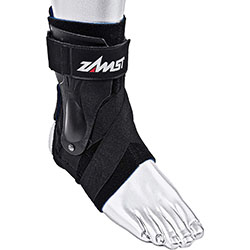
Click here for the lowest price on Amazon
Those suffering from recurring ankle problems or who have experienced a broken or dislocated ankle need real support. Like the kind supplied by the Zamst A2-DX Strong Support Ankle Brace. This aptly named brace provides twin stabilizers on each side of the ankle that keep things properly aligned. This allows the joint time to heal properly and prevents a recurrence of the injury.
What we like: This is an ankle brace after the heart of the active person. The A2-DX does not interfere with mobility to any significant degree. Which is quite a trick in its own right. The design also provides generous arch support.
The combination of support, comfort and flexibility is first-rate. So if you’re looking for an ankle brace that’s certain to keep everything properly aligned and can be worn to the gym, here it is.
Flaws: It’s too much for someone who just wants to bolster the strength of their ankle a bit. Not for those with Achilles tendinitis. It’s also pretty expensive.
8. Crucial Compression Foot & Ankle Compression Sleeves
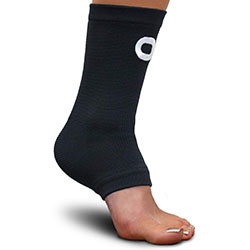
Click here for the lowest price on Amazon
Compression sleeve ankle braces slip on like a sock and take up residence between the arch and the upper ankle joint. They’re typically light, stretchy and provide just enough support to allow you to go about your business without worrying about a nuisance sprain. Many older folks wear these during any type of vigorous exercise or activity as a matter of course. And most doctors agree that’s a good idea.
What we like: The Crucial Compression Foot & Ankle Compression Sleeve is comfortable, highly breathable and provides arch and Achilles support. In addition, there’s plenty of ankle support and it’s available at a very agreeable price.
Flaws: While most people will find it more than adequate for everyday activities, if you’re recovering from a serious injury you may want something more formidable.
9. SNEINO Ankle Brace
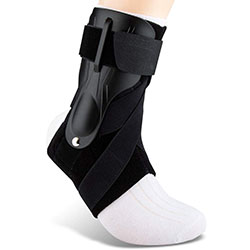
Click here for the lowest price on Amazon
The Sneino Ankle Brace is purpose-built to provide firm lateral support for ankles weakened by injury, repetitive use or degenerative conditions like arthritis. A weakened ankle is far more likely to twist and turn in an unnatural manner and the Sneino Ankle Brace can prevent that from happening.
What we like: This is a good brace for people who’ve experienced traumatic injury or whose ankle joints are under assault from age-related maladies.
So, if you’ve suffered ankle injuries in the past but want to stay active the Sneino Ankle Brace should help. Hiking, bike riding, aerobics or going for a jog with the dog are all back on the table. The reasonable price is also a plus.
Flaws: Our only quibble has more to do with the marketing for this brace than the brace itself. That quibble concerns company claims that this is a great brace for those suffering from Achilles tendinitis. With its open heel that’s not really the case.
10. SB Sox Compression Ankle Brace
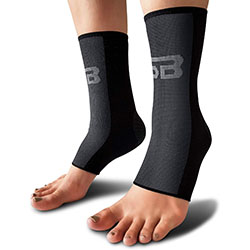
Click here for the lowest price on Amazon
Sometimes you don’t need rigid plates sandwiching your ankle joint. You just need a bit more support because the years are adding up and you’re not willing to forego your active lifestyle. And why should you? The SB Sox Compression Ankle Brace is a comfortable, lightweight piece of gear.
What we like: It slips on easily, provides arch, heel and ankle support and is fashioned from moisture wicking fabric that keeps you cool and dry. It also encourages proper blood circulation even when you’re inactive. You can also pop it in the washer when dirty.
All in all the SB Sox Compression Brace will allow you to engage in your favorite physical pursuits without the specter of painful ankle turns looming over the proceedings.
Flaws: Hard to find flaws here. It’s a simple device that works as advertised. If we were to nitpick we might point to the lack of color options.
How We Ranked
Compression braces are typically used by those who just need to buttress the integrity of their ankle joint a bit. When it comes to more supportive ankle braces you typically have your choice of rigid side plates or a lace-style braces. In most cases the lace-style ankle brace tends to be less restrictive than that which uses the rigid support plates down the sides. Our interest was in finding braces which – regardless of which type of support they offered – did so effectively and with minimal hassle.
Most ankle braces offer either Velcro (1) closures or lace closures. Velcro closures are much easier to use and offer outstanding firmness and adjustability. Their downside is that, if used regularly, they tend to wear out faster than laces. When ranking the ankle braces on our list we put both closure types through the testing wringer and chose only those that enabled a firm, reliable hold.
With ankle braces durability is almost entirely a function of build quality. A lot of ankle braces look good and when you slip them on the first time they may even feel like they’re up to the job. Some, however, start breaking down almost immediately. Stitching begins to pull apart, the discount Velcro used in the closure becomes flattened and ineffective after a few uses, or the material begins to stretch or otherwise lose its integrity. We had our testers wear each ankle brace on multiple occasions and run the performance gauntlet in order to weed out the phonies.
The ankle brace is going to wrap around a good portion of the foot. Which means it’s going to be susceptible to foot odors to the same degree your socks will be. Not only that but a dirty ankle brace can play host to bacteria and cause irritation of the skin (2). Therefore, it’s important that a good ankle brace be low maintenance and easy to clean. Most braces will come with clear and simple cleaning instructions. If a particular brace did not offer common sense cleaning instructions it did not make our list.
FAQs
Q: Who needs an ankle brace?
A: Those who simply want to provide a bit more support for their ankles should find compression braces to be more than adequate. That includes people with a history of twisting their ankle or those who have injured their ankle in the past and don’t want to risk a repeat. In addition, those recovering from a serious ankle injury need an ankle brace during all phases of recovery. Ankle braces are also useful for those with plantar fasciitis. And finally, an ankle brace can be useful for people who suffer from Achilles tendinitis.
Q: How often should you replace an ankle brace?
A: This is something most people don’t consider when buying an ankle brace. But because your ankles are typically under more stress than any other joint in your body the ankle brace will often need to be replaced more often than, say, an elbow brace. As such, if you use your ankle brace on an intermittent basis you’ll probably want to replace it every 6 months or so. If you use it every day then you should replace it after a couple of months.
Q: Should I wear a brace on each ankle?
A: That depends on why you are using the ankle joint to begin with. If you are using it to address a specific injury to one of your ankles there’s no reason to wear a brace on both ankles. However, if you are over 50 and still physically active you may well want to wear compression braces on all the major joints when skiing, for instance. Just to minimize the chance of incurring an injury. While ankle braces are not thought to reduce the severity of an injury they may prevent it from occurring in the first place (3), which is even more valuable for older folks.
Q: Will a rigid ankle brace interfere with walking?
A: There is no reliable information that suggests this is the case. In fact, it’s likely an ankle brace will actually enhance physical performance by providing you the support you need to be your best. NBA, NFL, Premier League soccer players and more all wear ankle braces while playing with no reduction in performance. So the notion that an ankle brace will interfere with everyday activity seems far-fetched. Regardless of your age.
Q: Can an ankle brace cause knee problems?
A: There is no credible evidence to suggest that wearing an ankle brace can cause knee problems. From a physiological perspective if sufficient force is brought to bear on a the knee it will create an injury. And that’s true whether you’re wearing an ankle brace or not. So while an ankle brace can prevent an ankle injury it won’t prevent or cause a knee injury.
Q: What’s the difference between a rigid and lace-up brace?
A: It’s a matter of the degree of protection they offer. Lace up braces offer a moderate to high degree of protection that doesn’t compromise freedom of movement or overall comfort. They’re also typically less expensive than right braces. Rigid braces provide the highest degree of protection you can get, aside from a fully rigid boot. Which is why they are commonly used in the aftermath of broken or dislocated ankles.
Q: Are there any side effects to wearing an ankle bracelet?
A: There is some evidence to suggest that wearing semi-rigid ankle braces can lead to balance and postural problems (4). Particularly in those who wear them on both ankles simultaneously. At the same time, however, doctors often have little choice but to recommend a rigid or semi-rigid ankle brace in order to facilitate healing. The trick seems to be knowing when to use a flexible brace, when to go for a semi-rigid or rigid brace and when people using a rigid brace should transition to a less restrictive ankle brace.
Q: Will an ankle brace weaken my ankle muscles?
A: The only way an ankle brace may wind up compromising the integrity of a joint is if a person wears one constantly for no apparent reason. If the brace is worn as part of a rehabilitation program or to help prevent injury during strenuous activity there’s no evidence it will result in a weakening of the ankle joint.
Q: Can I machine wash an ankle brace?
A: Many brands of compression ankle braces can be tossed into the washing machine. Others however, need to be hand washed and air dried. When it comes to the more rigid types of ankle brace you’ll need to read the cleaning and care instructions that come with the brace. But you can be reasonably certain you’ll need to hand wash them.
Q: How do I determine the right size ankle brace?
A: If your shoe size fits into the ½ category (say, size 10 ½) then look for an ankle brace designed for the next lowest full size. (For instance a size 10.) This will help ensure the brace provides adequate support regardless of your activity.
Related Articles
Knee sleeves
Back braces
Knee braces
Tennis elbow braces
Recap
Today’s ankle braces are marvels of economy and effectiveness and are a convenient way to prevent everything from common sprains to full-on fractures.
If you have a history of ankle sprains or have endured a serious ankle injury in the past, an ankle brace should be considered standard gear for skiing snowboarding, rollerblading, ice skating or running. This is doubly true if you are over 50.
For cpoe.org’s #1 recommended ankle brace, click here.

